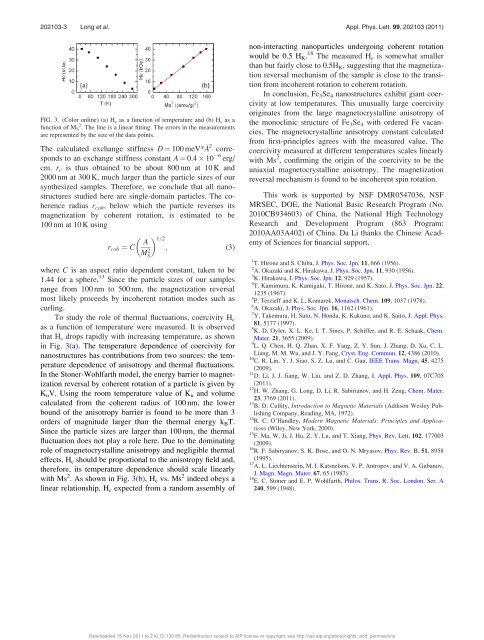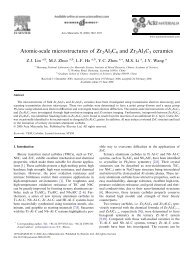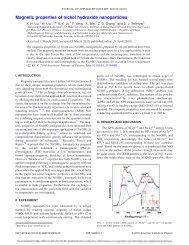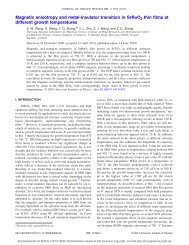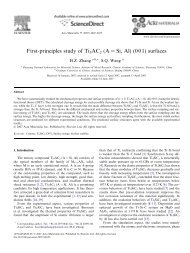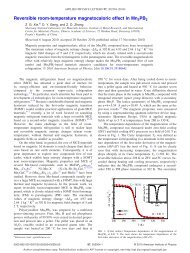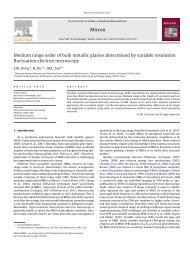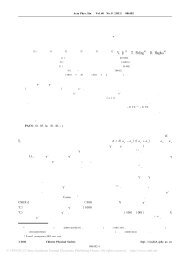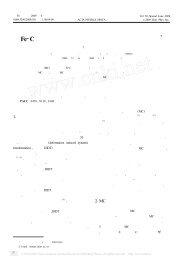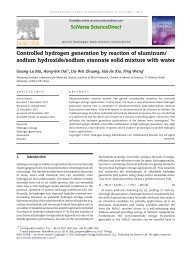Magnetic anisotropy and coercivity of Fe3Se4 nanostructures
Magnetic anisotropy and coercivity of Fe3Se4 nanostructures
Magnetic anisotropy and coercivity of Fe3Se4 nanostructures
Create successful ePaper yourself
Turn your PDF publications into a flip-book with our unique Google optimized e-Paper software.
202103-3 Long et al. Appl. Phys. Lett. 99, 202103 (2011)<br />
FIG. 3. (Color online) (a) H c as a function <strong>of</strong> temperature <strong>and</strong> (b) H c as a<br />
function <strong>of</strong> M S 2 . The line is a linear fitting. The errors in the measurements<br />
are represented by the size <strong>of</strong> the data points.<br />
The calculated exchange stiffness D ¼ 100 meV*A 2 corresponds<br />
to an exchange stiffness constant A ¼ 0.4 10 6 erg/<br />
cm. r c is thus obtained to be about 800 nm at 10 K <strong>and</strong><br />
2000 nm at 300 K, much larger than the particle sizes <strong>of</strong> our<br />
synthesized samples. Therefore, we conclude that all <strong>nanostructures</strong><br />
studied here are single-domain particles. The coherence<br />
radius r coh , below which the particle reverses its<br />
magnetization by coherent rotation, is estimated to be<br />
100 nm at 10 K using<br />
<br />
r coh ¼ C<br />
A 1=2<br />
MS<br />
2 ; (3)<br />
where C is an aspect ratio dependent constant, taken to be<br />
1.44 for a sphere. 13 Since the particle sizes <strong>of</strong> our samples<br />
range from 100 nm to 500 nm, the magnetization reversal<br />
most likely proceeds by incoherent rotation modes such as<br />
curling.<br />
To study the role <strong>of</strong> thermal fluctuations, <strong>coercivity</strong> H c<br />
as a function <strong>of</strong> temperature were measured. It is observed<br />
that H c drops rapidly with increasing temperature, as shown<br />
in Fig. 3(a). The temperature dependence <strong>of</strong> <strong>coercivity</strong> for<br />
<strong>nanostructures</strong> has contributions from two sources: the temperature<br />
dependence <strong>of</strong> <strong>anisotropy</strong> <strong>and</strong> thermal fluctuations.<br />
In the Stoner-Wohlfarth model, the energy barrier to magnetization<br />
reversal by coherent rotation <strong>of</strong> a particle is given by<br />
K u V. Using the room temperature value <strong>of</strong> K u <strong>and</strong> volume<br />
calculated from the coherent radius <strong>of</strong> 100 nm, the lower<br />
bound <strong>of</strong> the <strong>anisotropy</strong> barrier is found to be more than 3<br />
orders <strong>of</strong> magnitude larger than the thermal energy k B T.<br />
Since the particle sizes are larger than 100 nm, the thermal<br />
fluctuation does not play a role here. Due to the dominating<br />
role <strong>of</strong> magnetocrystalline <strong>anisotropy</strong> <strong>and</strong> negligible thermal<br />
effects, H c should be proportional to the <strong>anisotropy</strong> field <strong>and</strong>,<br />
therefore, its temperature dependence should scale linearly<br />
with Ms 2 . As shown in Fig. 3(b), H c vs. Ms 2 indeed obeys a<br />
linear relationship. H c expected from a r<strong>and</strong>om assembly <strong>of</strong><br />
non-interacting nanoparticles undergoing coherent rotation<br />
would be 0.5 H K . 18 The measured H c is somewhat smaller<br />
than but fairly close to 0.5H K , suggesting that the magnetization<br />
reversal mechanism <strong>of</strong> the sample is close to the transition<br />
from incoherent rotation to coherent rotation.<br />
In conclusion, Fe 3 Se 4 <strong>nanostructures</strong> exhibit giant <strong>coercivity</strong><br />
at low temperatures. This unusually large <strong>coercivity</strong><br />
originates from the large magnetocrystalline <strong>anisotropy</strong> <strong>of</strong><br />
the monoclinic structure <strong>of</strong> Fe 3 Se 4 with ordered Fe vacancies.<br />
The magnetocrystalline <strong>anisotropy</strong> constant calculated<br />
from first-principles agrees with the measured value. The<br />
<strong>coercivity</strong> measured at different temperatures scales linearly<br />
with Ms 2 , confirming the origin <strong>of</strong> the <strong>coercivity</strong> to be the<br />
uniaxial magnetocrystalline <strong>anisotropy</strong>. The magnetization<br />
reversal mechanism is found to be incoherent spin rotation.<br />
This work is supported by NSF DMR0547036, NSF<br />
MRSEC, DOE, the National Basic Research Program (No.<br />
2010CB934603) <strong>of</strong> China, the National High Technology<br />
Research <strong>and</strong> Development Program (863 Program:<br />
2010AA03A402) <strong>of</strong> China. Da Li thanks the Chinese Academy<br />
<strong>of</strong> Sciences for financial support.<br />
1 T. Hirone <strong>and</strong> S. Chiba, J. Phys. Soc. Jpn. 11, 666 (1956).<br />
2 A. Okazaki <strong>and</strong> K. Hirakawa, J. Phys. Soc. Jpn. 11, 930 (1956).<br />
3 K. Hirakawa, J. Phys. Soc. Jpn. 12, 929 (1957).<br />
4 T. Kamimura, K. Kamigaki, T. Hirone, <strong>and</strong> K. Sato, J. Phys. Soc. Jpn. 22,<br />
1235 (1967).<br />
5 P. Terzieff <strong>and</strong> K. L. Komarek, Monatsch. Chem. 109, 1037 (1978).<br />
6 A. Okazaki, J. Phys. Soc. Jpn. 16, 1162 (1961).<br />
7 Y. Takemura, H. Suto, N. Honda, K. Kakuno, <strong>and</strong> K. Saito, J. Appl. Phys.<br />
81, 5177 (1997).<br />
8 K. D. Oyler, X. L. Ke, I. T. Sines, P. Schiffer, <strong>and</strong> R. E. Schaak, Chem.<br />
Mater. 21, 3655 (2009).<br />
9 L. Q. Chen, H. Q. Zhan, X. F. Yang, Z. Y. Sun, J. Zhang, D. Xu, C. L.<br />
Liang, M. M. Wu, <strong>and</strong> J. Y. Fang, Cryst. Eng. Commun. 12, 4386 (2010).<br />
10 C. R. Lin, Y. J. Siao, S. Z. Lu, <strong>and</strong> C. Gau, IEEE Trans. Magn. 45, 4275<br />
(2009).<br />
11 D. Li, J. J. Jiang, W. Liu, <strong>and</strong> Z. D. Zhang, J. Appl. Phys. 109, 07C705<br />
(2011).<br />
12 H. W. Zhang, G. Long, D. Li, R. Sabirianov, <strong>and</strong> H. Zeng, Chem. Mater.<br />
23, 3769 (2011).<br />
13 B. D. Cullity, Introduction to <strong>Magnetic</strong> Materials (Addison Wesley Publishing<br />
Company, Reading, MA, 1972).<br />
14 R. C. O’H<strong>and</strong>ley, Modern <strong>Magnetic</strong> Materials: Principles <strong>and</strong> Applications<br />
(Wiley, New York, 2000).<br />
15 F. Ma, W. Ji, J. Hu, Z. Y. Lu, <strong>and</strong> T. Xiang, Phys. Rev. Lett. 102, 177003<br />
(2009).<br />
16 R. F. Sabiryanov, S. K. Bose, <strong>and</strong> O. N. Mryasov, Phys. Rev. B. 51, 8958<br />
(1995).<br />
17 A. L. Liechtenstein, M. I. Katsnelson, V. P. Antropov, <strong>and</strong> V. A. Gubanov,<br />
J. Magn. Magn. Mater. 67, 65 (1987).<br />
18 E. C. Stoner <strong>and</strong> E. P. Wohlfarth, Philos. Trans. R. Soc. London, Ser. A<br />
240, 599 (1948).<br />
Downloaded 15 Nov 2011 to 210.72.130.85. Redistribution subject to AIP license or copyright; see http://apl.aip.org/about/rights_<strong>and</strong>_permissions


